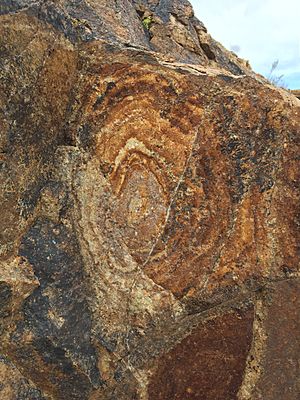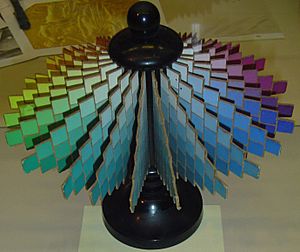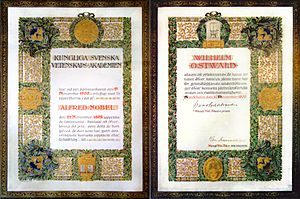Wilhelm Ostwald facts for kids
Quick facts for kids
Wilhelm Ostwald
|
|
|---|---|
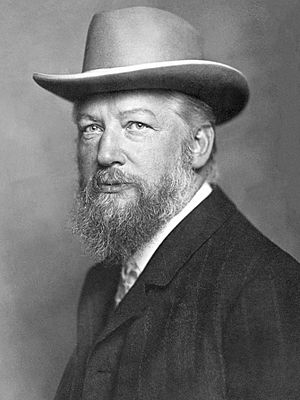
Ostwald c. 1913
|
|
| Born |
Friedrich Wilhelm Ostwald
2 September [O.S. 21 August] 1853 Riga, Governorate of Livonia, Russian Empire
|
| Died | 4 April 1932 (aged 78) Großbothen, Amtshauptmannschaft Grimma, Saxony, Weimar Republic
|
| Alma mater | Imperial University of Dorpat |
| Known for |
|
| Awards |
|
| Scientific career | |
| Fields | Physical chemistry |
| Institutions |
|
| Doctoral advisor | Carl Schmidt |
| Doctoral students |
|
Friedrich Wilhelm Ostwald (German pronunciation: [ˈvɪlhɛlm ˈɔstˌvalt]; September 2, 1853 – April 4, 1932) was a Baltic German chemist and philosopher. He is known as one of the founders of physical chemistry. This field studies how physics and chemistry work together. Other founders included Jacobus Henricus van 't Hoff, Walther Nernst, and Svante Arrhenius.
Ostwald won the Nobel Prize in Chemistry in 1909. He received it for his important work on catalysis, which is about speeding up chemical reactions. He also studied chemical balance and how fast reactions happen.
After he retired from teaching in 1906, Ostwald became very involved in philosophy, art, and politics. He made big contributions in these areas too. People often describe him as a polymath, meaning he was an expert in many different subjects.
Contents
Early Life and Learning
Wilhelm Ostwald was born in Riga, which was part of the Russian Empire at the time. Today, Riga is the capital of Latvia. His father, Gottfried Wilhelm Ostwald, was a master barrel maker. His mother was Elisabeth Leuckel. Wilhelm was the middle child of three.
Even as a child, Ostwald loved science. He did many experiments at home. He was especially interested in fireworks and photography.
In 1872, Ostwald started studying at the University of Dorpat (now the University of Tartu in Estonia). He finished his first set of exams there in 1875. While at Dorpat, he learned a lot about the humanities, arts, and philosophy. These subjects became very important to him after he retired from science.
His Career in Science
Ostwald began working at the University of Dorpat in 1875. He was an unpaid researcher at first. He worked in the lab of Carl Schmidt. There, he learned about analyzing inorganic compounds and measuring chemical balance. He also learned about reaction rates. These early studies helped shape his later research. Ostwald also worked in the university's physics institute.
Around 1877, Ostwald became a paid assistant in the Physics Institute. He also taught math and science at a high school to support himself.
Ostwald was very interested in how chemicals combine. He wanted to understand what makes reactions happen and form new compounds. This was a big question for chemists back then. He created a special table to show how chemicals react at different temperatures. He also studied mass action, electrochemistry, and how fast chemical reactions occur.
Ostwald earned his Magisterial degree in 1877. This allowed him to give lectures and charge for his teaching. He finished his doctoral dissertation in 1878. His paper was about "Volumetric and Optical-Chemical Studies." In 1879, he became a paid assistant to Carl Schmidt.
In 1881, Ostwald became a Professor of Chemistry at the Riga Polytechnicum (now Riga Technical University). Then, in 1887, he moved to Leipzig University. There, he became a Professor of Physical Chemistry. He stayed at Leipzig University until he retired in 1906. He also taught at Harvard University in 1904 and 1905 as the first "exchange professor."
Many of Ostwald's students became famous scientists. These included future Nobel Prize winners like Svante Arrhenius, Jacobus Henricus van 't Hoff, and Walther Nernst. Other students, like Arthur Amos Noyes and Willis R. Whitney, also made big contributions to physical chemistry.
In 1901, Albert Einstein wanted to work in Ostwald's lab. This was four years before Einstein published his famous work on special relativity. Ostwald did not accept Einstein at that time. However, they later became good friends and respected each other's work. Ostwald even nominated Einstein for the Nobel Prize in 1910 and 1913.
After retiring in 1906, Ostwald spent his time on philosophy, politics, and other subjects. During his career, he wrote over 500 research papers and about 45 books.
His Scientific Discoveries
Making Nitric Acid
Ostwald created a way to make nitric acid cheaply. This process uses ammonia and a catalyst to speed up the reaction. He got patents for this invention. His method made it possible to produce a lot of nitric acid.
Another chemist, Kuhlmann, had patented a similar process earlier. But it wasn't used much because ammonia was expensive. Later, Fritz Haber and Carl Bosch invented a way to make cheap ammonia. When combined with Ostwald's method, this led to much larger and cheaper production of fertilizers and explosives. This was very important, especially for Germany during World War I. This process is still widely used today and is called the Ostwald process.
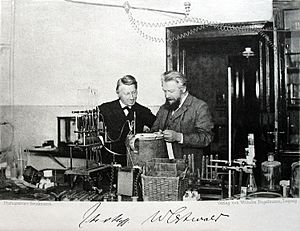
Ostwald's Dilution Law
Ostwald also did important research on how solutions become diluted. This led to his "Ostwald's Dilution Law." This law explains that weak electrolytes (substances that conduct electricity in solution) become more spread out when they are very diluted. You can see this effect in experiments, like those involving electricity.
Understanding Catalysis
Through his studies of reaction rates and acids, Ostwald found that the amount of acid or base in a solution can greatly affect how fast a chemical reaction happens. He realized this was related to catalysis, an idea first described by Berzelius.
Ostwald explained that a catalyst is a substance that makes a chemical reaction go faster. But the catalyst itself does not get used up or become part of the final products. Ostwald's ideas about catalysis were very useful. They helped explain biological processes, like how enzymes work, and many industrial processes. The nitric acid process he invented also uses a catalyst.
How Crystals Form
Ostwald studied how solids form crystals. He was especially interested in materials that can crystallize in different forms, a process called polymorphism. He found that solids don't always form the most stable crystal shape first. Instead, they might form other shapes depending on how fast each shape crystallizes. Ostwald discovered that this depends on the surface tension between the solid and the liquid. Many common materials, like minerals and organic compounds, show this behavior. This discovery became known as Ostwald's rule.
Ostwald also realized that solid or liquid solutions can change over time. Even if a less stable crystal forms first, more stable shapes can develop as the solution gets older. This often leads to larger crystals forming, because they are more stable than many small ones. This process is called Ostwald Ripening. You can see it when ice cream gets gritty as it ages. Over long geologic periods, many minerals also change their crystal forms through Ostwald Ripening.
Ostwald also found that how easily a solid dissolves depends on the size of its crystals. Very small crystals, usually less than a micron, dissolve more easily. Ostwald explained this with a mathematical equation called the Ostwald-Freundlich equation. He first published this in 1900. This equation also considers the surface tension of the particles and the temperature. This idea is sometimes used when making medicines that don't dissolve well. Making the drug particles very small helps the body absorb them better. This size effect also plays a role in Ostwald Ripening.
Working with German chemist Raphael E. Liesegang, Ostwald noticed that substances can crystallize in a repeating pattern. This can create visual patterns, like those seen in various rock formations. Liesegang had studied this in his lab. Ostwald then created a mathematical model to explain these observations. He realized how common this periodic crystallization behavior is. These patterns are now known as Liesegang rings.
Atomic Ideas
Around 1900, Ostwald introduced the word "mole" into chemistry. He defined one mole as the molecular weight of a substance in grams. He linked this idea to the behavior of ideal gases. It's interesting that Ostwald developed the mole concept even though he didn't believe in atomic theory at first. He was one of the last scientists, along with Ernst Mach, to doubt the existence of atoms. However, he later changed his mind. He said that Jean Perrin's experiments on Brownian motion convinced him that atoms exist.
In 1906, Ostwald joined the International Committee on Atomic Weights. He left this committee in 1917 because of World War I.
Scientific Tools
Ostwald studied chemical balance and how acids and bases interact. He realized that many common ways of studying chemicals could change the system being measured. So, he started using physical measurements instead.
One such measurement was viscosity, which is how much a liquid resists flowing. Ostwald invented a device for this. It has bulbs that hold liquid and a thin tube (capillary) between them. The time it takes for the liquid to flow through the tube tells you its viscosity. He used this to study how substances behave in water. These devices are called Ostwald viscometers and are still used today in labs and for quality control.
Ostwald also designed a pipette to measure and transfer liquids, especially body fluids. This design was later improved by Otto Folin. This type of pipette has a special bulb at the bottom. It is known as the Ostwald-Folin pipette and is still widely used.
Color Science
After retiring in 1906, Ostwald became very interested in organizing colors. He thought this would be useful for both science and art. He published The Color Primer and The Color Atlas between 1916 and 1918. These books showed how different colors relate to each other.
Ostwald created a three-dimensional model of color space. It looks like two cones joined at their bases. One point of the cone is pure white, and the other is pure black. The eight main colors are arranged around the sides of the cones. In this system, every color is a mix of white, black, and the eight main colors. This means each color can be described by three numbers.
This way of showing colors was an important step in organizing them. It replaced simply seeing colors with an objective system. Over time, Ostwald's ideas became part of the HSL and HSV color system, which is still used today. Much of his work on color was done with the Deutscher Werkbund, a group of painters and architects.
Contributions to Humanities and Society
Wilhelm Ostwald was active in many areas beyond chemistry. He wrote many philosophical works, totaling about forty thousand pages. He also supported the peace movement led by Berta von Suttner.
Ostwald loved to paint as a hobby and even made his own paints. He created over 1,000 paintings and 3,000 pastel and color studies. For Ostwald, science and art supported each other. He believed both aimed to understand the world by creating clear ideas. Science built "intellectual ideas," while art built "visual ones."
In his later years, Ostwald became very interested in color theory. He wrote books like Malerbriefe (Letters to a Painter, 1904) and Die Farbenfibel (The Color Primer, 1916). His color ideas were influenced by Albert Henry Munsell. In turn, Ostwald's theories influenced artists like Piet Mondrian and others from De Stijl, as well as Paul Klee and artists from the Bauhaus school.
He was also interested in the idea of a universal language. He learned Esperanto first, then supported Ido. He was part of a committee that worked on an international helper language. Ostwald even gave half of his 1909 Nobel Prize money to the Ido movement. This money helped fund the Ido magazine Progreso, which he had suggested in 1908.
One of Ostwald's main interests was bringing things together through organization. He believed that energy efficiency was a key idea in all parts of society and culture. This interest in efficiency even extended to his political views, like the need for organized labor.
Ostwald's desire for organization led him to adopt the philosophy of Monism. This idea aimed to find a scientific basis for values that could support social and political changes. Ostwald himself created a system of ethics based on science. Its main idea was: "do not waste energy, but convert it into its most useful form."
Awards and Recognition
Ostwald received the 1909 Nobel Prize for Chemistry. This was for his work on catalysis and his studies of chemical balance and reaction rates. He was nominated for the Nobel Prize 20 times starting in 1904. After winning, he nominated other scientists for the Nobel Prize nine times, including Albert Einstein twice. Ostwald gave over $40,000 of his Nobel Prize money to support the Ido language.
In 1923, Ostwald received the Wilhelm Exner Medal. This award recognized how much his scientific work helped the economy.
He became an honorary member of scientific groups in many countries, including Germany, Sweden, Norway, the Netherlands, Russia, Great Britain, and the United States. He also received honorary doctorates from several universities. In 1899, the King of Saxony recognized his scientific achievements by making him a Geheimrat.
There is a Wilhelm Ostwald Park and Museum in Grimma, Germany. It is located at his old vacation home. This museum also holds many of his scientific works.
A crater on the far side of the Moon is named Ostwald crater in his honor.
Personal Life
On April 24, 1880, Ostwald married Helene von Reyher. They had five children together: Grete, Wolfgang, Elisabeth, Walter, and Carl Otto. His son, Wolfgang Ostwald, also became a well-known scientist, studying colloid chemistry.
Ostwald was a member of the Scottish Rite Masonry. He became the Grand Master of a lodge in Bayreuth.
In 1887, he moved to Leipzig, Germany, where he worked for the rest of his life. When he retired, he moved to a country home near Groβbothen, Saxony. He called his home "Landhaus Energie" (Country House Energy). He lived there for most of his later years.
Wilhelm Ostwald was an atheist. He passed away in a hospital in Leipzig on April 4, 1932. He was first buried at his country estate in Großbothen. Later, he was re-buried in the Great Cemetery of Riga.
In Books
Ostwald appears as a character in the 2010 novel A Curable Romantic by Joseph Skibell.
He is also mentioned in Zeno's Conscience, a 1923 novel by Italo Svevo.
Images for kids
See also
 In Spanish: Wilhelm Ostwald para niños
In Spanish: Wilhelm Ostwald para niños
- Colligative properties
- Electrode potential
- Energeticism
- List of Baltic German scientists
- Timeline of hydrogen technologies
- Wilhelm Ostwald Institute


